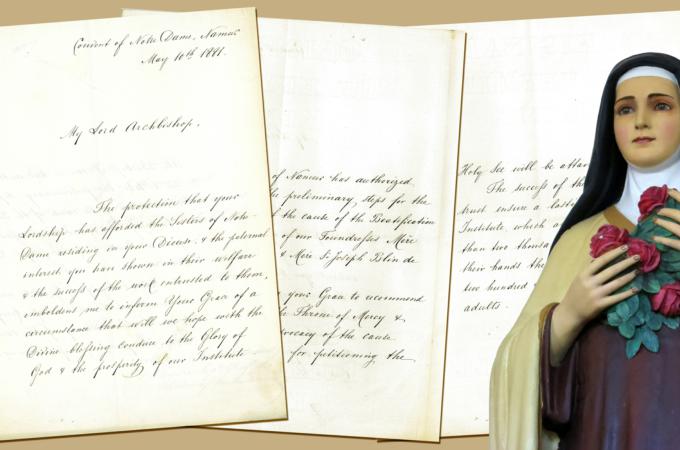The foundress of the Sisters of Notre Dame de Namur
On May 10, 1881, Mother Aloysie, superior of the Sisters of Notre Dame de Namur, wrote to Archbishop John J. Williams of Boston. She reveals that "the Bishop of Namur has authorized me to take the preliminary steps for the introduction of the cause of the Beatification and Canonization of our Foundresses Mere Julie Billiart (and) Mere St. Joseph Blin de Bourdon," and appeals for Bishop William's support.
St. Julie Billiart was born Marie Rose Julie Billiart in Cuvilly, France, on July 12, 1751. From an early age, she showed an inclination towards religion, often sharing her knowledge with other children. Misfortune befell her family, requiring her to work and help support them, but she continued to share her faith, teach others to pray, and visit the sick.
One day, while she was seated next to him, someone attempted to murder her father, the bullet missing its target. The shock caused her to become ill, eventually rendering her immobile, but from her sick bed she continued to teach and counsel visitors.
During the French Revolution, she was not in favor of the anti-Catholic policies of the new government, and was known to have hidden fugitive priests in her home. After being threatened for her public views, she was removed from her home and eventually arrived in Amiens. There, with the help of Father Joseph Varin, she founded the Institute of Notre Dame as a place to teach and nurture the faith of poor children. This evolved to offer a Catholic education to poor girls, and offered instruction to their teachers.
In 1804, the Fathers of the Faith held a mission in Amiens, and one of the priests asked Mother Billiart to join him in a novena for an unknown intention. On the fifth day, the Feast of the Sacred Heart, he said "Mother, if you have any faith, take one step in honor of the Sacred Heart of Jesus." For the first time in 22 years, she rose from her seat and was able to walk.
Mobile for the first time in over two decades, Mother Billiart's activities increased, expanding the institute at Amiens, visiting missions, and opening additional convents. A setback occurred when the sisters were estranged from some of the clergy in Amiens, including the bishop, and removed to the motherhouse in Namur, Belgium, from which the order takes its name.
Mother Billiart continued to lead the order until her death on April 8, 1816, at Namur, and was succeeded by Sister St. Joseph. Though this letter was written in 1881, Mother Julie Billiart was not beatified until nearly 20 years later, May 13, 1906. Her feast day is April 8.
The Sisters of Notre Dame de Namur have played a significant role in New England Catholic education since their arrival in 1849. That same year, the first three sisters arrived from Cincinnati at the invitation of Father John McElroy, SJ, one of the founders of Boston College. That year they established St. Mary's School, the first parochial school in the diocese, in Boston's North End.
Within the ensuing decade, they would be the first to offer evening classes; establish an industrial school and the Academy of Notre Dame, both for girls; and celebrate the first Mass in their new convent chapel on Lancaster Street. Over the next century, they would establish more than one dozen schools in the diocese, and even more throughout New England. They would continue to play a significant role in Catholic education into the 20th Century, founding Emmanuel College, the first Catholic women's college in New England, which opened in 1919.
- Thomas Lester is the archivist of the Archdiocese of Boston.



















